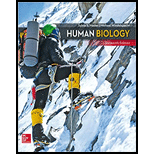
HUMAN BIOLOGY-EBOOK ACCESS (180 DAY)
16th Edition
ISBN: 9781260918410
Author: Mader
Publisher: MCG
expand_more
expand_more
format_list_bulleted
Question
Chapter 13.4, Problem 3CYP
Summary Introduction
To analyze:
The symptoms of muscular dystrophy.
Introduction:
A group of muscle diseases where increasing weakening and breakdown of skeletal muscles takes place is known as muscular dystrophy.
Expert Solution & Answer
Want to see the full answer?
Check out a sample textbook solution
Students have asked these similar questions
Hair follicle formation is thought to result from a reaction-diffusion mechanism with Wnt and its antagonist Dkk1. How is Dkk1 regulated by Wnt? Describe specific cis-regulatory elements and the net effect on Dkk1 expression.
Limetown S1E4 Transcript: E
n 2025SP-BIO-111-PSNT1: Natu
X
Natural Selection in insects
X
+
newconnect.mheducation.com/student/todo
CA
NATURAL SELECTION NATURAL SELECTION IN INSECTS (HARDY-WEINBERG LAW)
INTRODUCTION
LABORATORY SIMULATION
A Lab Data
Is this the correct allele frequency?
Is this the correct genotype frequency?
Is this the correct phenotype frequency?
Total
1000
Phenotype Frequency
Typica
Carbonaria
Allele Frequency
9
P
635
823
968
1118
1435
Color
Initial Frequency
Light
0.25
Dark
0.75
Frequency Gs
0.02
Allele
Initial Allele Frequency
Gs Allele Frequency
d
0.50
0
D
0.50
0
Genotype Frequency
Moths
Genotype
Color
Moths
Released
Initial
Frequency
Frequency G5
Number of
Moths Gs
NC
- X
Which of the following is not a sequence-specific DNA binding protein?
1. the catabolite-activated protein
2. the trp repressor protein
3. the flowering locus C protein
4. the flowering locus D protein
5. GAL4
6. all of the above are sequence-specific DNA binding proteins
Chapter 13 Solutions
HUMAN BIOLOGY-EBOOK ACCESS (180 DAY)
Ch. 13.1 - List the three types of muscles and provide a...Ch. 13.1 - Prob. 2LOCh. 13.1 - Prob. 3LOCh. 13.1 - State the three types of muscles in the human body...Ch. 13.1 - Prob. 2CYPCh. 13.1 - Prob. 3CYPCh. 13.2 - Prob. 1LOCh. 13.2 - Prob. 2LOCh. 13.2 - Prob. 3LOCh. 13.2 - Prob. 1BTS
Ch. 13.2 - Prob. 2BTSCh. 13.2 - Prob. 1CYPCh. 13.2 - Prob. 2CYPCh. 13.2 - Prob. 3CYPCh. 13.3 - Prob. 1LOCh. 13.3 - Prob. 2LOCh. 13.3 - Prob. 3LOCh. 13.3 - Prob. 4LOCh. 13.3 - Prob. 1BTSCh. 13.3 - Prob. 2BTSCh. 13.3 - List the stages of a muscle twitch.Ch. 13.3 - Contrast the activities of a single muscle twitch...Ch. 13.3 - Summarize how the CP pathway, fermentation, and...Ch. 13.3 - Explain why weightlifters are not well adapted for...Ch. 13.4 - Prob. 1LOCh. 13.4 - Summarize the causes of fibromyalgia, muscular...Ch. 13.4 - Prob. 1BTHCh. 13.4 - Prob. 2BTHCh. 13.4 - Prob. 1CYPCh. 13.4 - Prob. 2CYPCh. 13.4 - Prob. 3CYPCh. 13.5 - Prob. 1LOCh. 13.5 - Prob. 2LOCh. 13.5 - Prob. 1CYPCh. 13.5 - Prob. 2CYPCh. 13.5 - Prob. 3CYPCh. 13 - Prob. 1ACh. 13 - Which of the following terms is not linked to its...Ch. 13 - Prob. 3ACh. 13 - Prob. 4ACh. 13 - Prob. 5ACh. 13 - Label each of the indicated items in the diagram...Ch. 13 - Prob. 7ACh. 13 - Prob. 8ACh. 13 - Prob. 9ACh. 13 - Prob. 10ACh. 13 - Prob. 11ACh. 13 - Prob. 12ACh. 13 - Prob. 1TCCh. 13 - Prob. 2TCCh. 13 - Prob. 3TC
Knowledge Booster
Similar questions
- Which of the following is not a DNA binding protein? 1. the lac repressor protein 2. the catabolite activated protein 3. the trp repressor protein 4. the flowering locus C protein 5. the flowering locus D protein 6. GAL4 7. all of the above are DNA binding proteinsarrow_forwardWhat symbolic and cultural behaviors are evident in the archaeological record and associated with Neandertals and anatomically modern humans in Europe beginning around 35,000 yBP (during the Upper Paleolithic)?arrow_forwardDescribe three cranial and postcranial features of Neanderthals skeletons that are likely adaptation to the cold climates of Upper Pleistocene Europe and explain how they are adaptations to a cold climate.arrow_forward
- Biology Questionarrow_forward✓ Details Draw a protein that is embedded in a membrane (a transmembrane protein), label the lipid bilayer and the protein. Identify the areas of the lipid bilayer that are hydrophobic and hydrophilic. Draw a membrane with two transporters: a proton pump transporter that uses ATP to generate a proton gradient, and a second transporter that moves glucose by secondary active transport (cartoon-like is ok). It will be important to show protons moving in the correct direction, and that the transporter that is powered by secondary active transport is logically related to the proton pump.arrow_forwarddrawing chemical structure of ATP. please draw in and label whats asked. Thank you.arrow_forward
- Outline the negative feedback loop that allows us to maintain a healthy water concentration in our blood. You may use diagram if you wisharrow_forwardGive examples of fat soluble and non-fat soluble hormonesarrow_forwardJust click view full document and register so you can see the whole document. how do i access this. following from the previous question; https://www.bartleby.com/questions-and-answers/hi-hi-with-this-unit-assessment-psy4406-tp4-report-assessment-material-case-stydu-ms-alecia-moore.-o/5e09906a-5101-4297-a8f7-49449b0bb5a7. on Google this image comes up and i have signed/ payed for the service and unable to access the full document. are you able to copy and past to this response. please see the screenshot from google page. unfortunality its not allowing me attch the image can you please show me the mathmetic calculation/ workout for the reult sectionarrow_forward
arrow_back_ios
SEE MORE QUESTIONS
arrow_forward_ios
Recommended textbooks for you
 Medical Terminology for Health Professions, Spira...Health & NutritionISBN:9781305634350Author:Ann Ehrlich, Carol L. Schroeder, Laura Ehrlich, Katrina A. SchroederPublisher:Cengage LearningCase Studies In Health Information ManagementBiologyISBN:9781337676908Author:SCHNERINGPublisher:Cengage
Medical Terminology for Health Professions, Spira...Health & NutritionISBN:9781305634350Author:Ann Ehrlich, Carol L. Schroeder, Laura Ehrlich, Katrina A. SchroederPublisher:Cengage LearningCase Studies In Health Information ManagementBiologyISBN:9781337676908Author:SCHNERINGPublisher:Cengage Human Physiology: From Cells to Systems (MindTap ...BiologyISBN:9781285866932Author:Lauralee SherwoodPublisher:Cengage Learning
Human Physiology: From Cells to Systems (MindTap ...BiologyISBN:9781285866932Author:Lauralee SherwoodPublisher:Cengage Learning

Medical Terminology for Health Professions, Spira...
Health & Nutrition
ISBN:9781305634350
Author:Ann Ehrlich, Carol L. Schroeder, Laura Ehrlich, Katrina A. Schroeder
Publisher:Cengage Learning

Case Studies In Health Information Management
Biology
ISBN:9781337676908
Author:SCHNERING
Publisher:Cengage


Human Physiology: From Cells to Systems (MindTap ...
Biology
ISBN:9781285866932
Author:Lauralee Sherwood
Publisher:Cengage Learning

